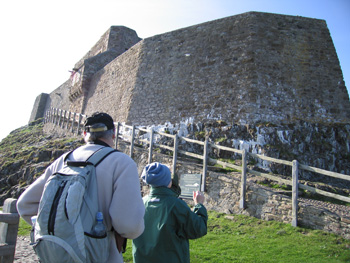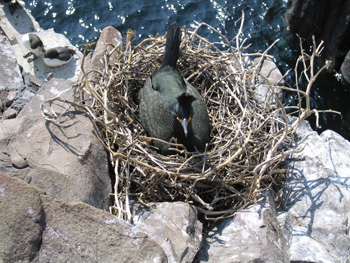Northumberland April 28th – May 3rd 2008 Holiday report
Guests attending
Roger and Sue Fitzwater
Monday 28th April
We stayed at Longhirst Hall just outside Morpeth in Northumberland and met up for pre-dinner drinks to discuss the week ahead. It soon became apparent that Roger and Sue wanted an in-depth look at Northumberland’s birds and landscapes, rather than a sprint around the county to see every last bird on offer, thus setting the tone for the week. With only two participants on this break it was easy to tailor-make the holiday to suit their wishes, concentrating on giving them close-up views of some of the region’s breeding species and honing their birding skills.
Tuesday 29th April
Encouraged by a cloudless sky, we drove north-east to Seahouses on the Northumberland coast and caught a boat across to Inner Farne, one of the islands owned and managed by the National Trust and home of tens of thousands of nesting seabirds. The first Puffins streamed past us on the boat ride out. The late spring had delayed seabird nesting and our arrival on Inner Farne was heralded by hundreds of Sandwich and Arctic terns loafing near the jetty in the prelude to their breeding. Once on the island, close ups of Eiders and Shags sitting on eggs excited us and the cacophony of Kittiwakes, Razorbills, Puffins and Guillemots courting and beginning their nest building and egg laying, was overwhelming. Our time on the island also included a brief chat with National Trust staff who were digesting some of the latest climate change impact forecasts for the Farnes. These wonderful seabirds might not have a bright future, as warming seas and changing climate space may alter their distribution around our coastline. Sobering news.
After a long late lunch, we headed north to Lindesfarne National Nature Reserve. Redshank, Grey Heron, Ringed Plover and Wheatear were seen on the drive across the island causeway. Continuing stunning weather helped encourage us on a gentle stroll to Lindesfarne Castle where we ended our birding day watching the nesting antics of several pairs of Fulmars trying to squeeze into small openings in the Castle walls.
Wednesday 30th April
 Heading south into the North Pennines, our day starting with a walk in Allen Banks, a National Trust woodland along the River Allen. This steep woodland valley provides a home for Dipper, Grey Wagtail, Goosander and Common Sandpiper. High water levels afforded us brief views of these birds but high winds and drizzle made woodland bird song hard to pick up. We failed to see the Pied Flycatcher, Redstart, and Wood Warbler that breed in this area.
Heading south into the North Pennines, our day starting with a walk in Allen Banks, a National Trust woodland along the River Allen. This steep woodland valley provides a home for Dipper, Grey Wagtail, Goosander and Common Sandpiper. High water levels afforded us brief views of these birds but high winds and drizzle made woodland bird song hard to pick up. We failed to see the Pied Flycatcher, Redstart, and Wood Warbler that breed in this area.
Driving further south into the hills, we stopped several times to watch parties of Black Grouse, Lapwing with chicks, Redshank, Snipe, Curlew and Wheatear. Again, the weather made birding difficult.
Thursday 1st May
After yesterday’s inclement weather we tried another woodland birding morning, spending time at Wallington, a National Trust Estate in mid-Northumberland. The mature parkland makes for good wildlife watching and, despite some heavy showers, we were treated by wonderful views of Bullfinch, Blackcap, Garden Warbler, a confiding nest- building Wren, Nuthatch, Marsh Tit, Sparrowhawk and three fat red squirrels.
After lunch we headed further north to a quiet moorland site that was home to one of England’s rarest breeding birds, the Hen Harrier. Protection of this site by a partnership of organisations has helped to give a rare opportunity to glimpse the breeding habits of this superb bird and, after a long walk, we were treated to the male harrier arriving with food and then passing it in mid-air to the female bird. This pair were still incubating eggs at this stage, but did manage to raise a healthy brood of chicks. Many thanks to the volunteer wardens who took the time to make us feel welcome and helped us see these birds.
Friday 2nd May
 Heading east, back to the coast, we spent the morning visiting a string of Northumberland Wildlife Trust wetland nature reserves along Druridge Bay. A mixture of walking and hide observation gave us great views of Reed Bunting, Yellowhammer, Oystercatcher, Little Grebe, several gull species, Tree Sparrow, Black-tailed Godwit and a host of waterfowl. This leisurely day became even more relaxed after a mix up with sailing times when we missed the last boat trip of the day out to Coquet Island where I had hoped we would see Roseate Tern. Roger and Sue were very forgiving!
Heading east, back to the coast, we spent the morning visiting a string of Northumberland Wildlife Trust wetland nature reserves along Druridge Bay. A mixture of walking and hide observation gave us great views of Reed Bunting, Yellowhammer, Oystercatcher, Little Grebe, several gull species, Tree Sparrow, Black-tailed Godwit and a host of waterfowl. This leisurely day became even more relaxed after a mix up with sailing times when we missed the last boat trip of the day out to Coquet Island where I had hoped we would see Roseate Tern. Roger and Sue were very forgiving!
Saturday May 3rd
With only a morning of birding available, we headed south to the National Trust Gibside Estate in the Derwent Valley. Gibside is one the estates involved in helping to restore the natural range of the Red Kite in England and is a great place to see these birds. Looking out from the ruined orangery, several kites were seen lazily circling across the valley. On a short stroll along the river, a streak of electric blue gave us a brief glimpse of Kingfisher to end the holiday.
Client comments from Roger and Sue
“Nick’s manner was sympathetic and enthusiastic and he showed a lot of patience.”
“Thank you for leading us to so many special Northumbrian places to glimpse the secret and public lives of birds – the wren building a nest, the eider on her eggs, the curlew’s preening, fabulous displays of lapwing, the magic of the Farnes, and much much more.”
Written by Nick Mason – holiday leader
